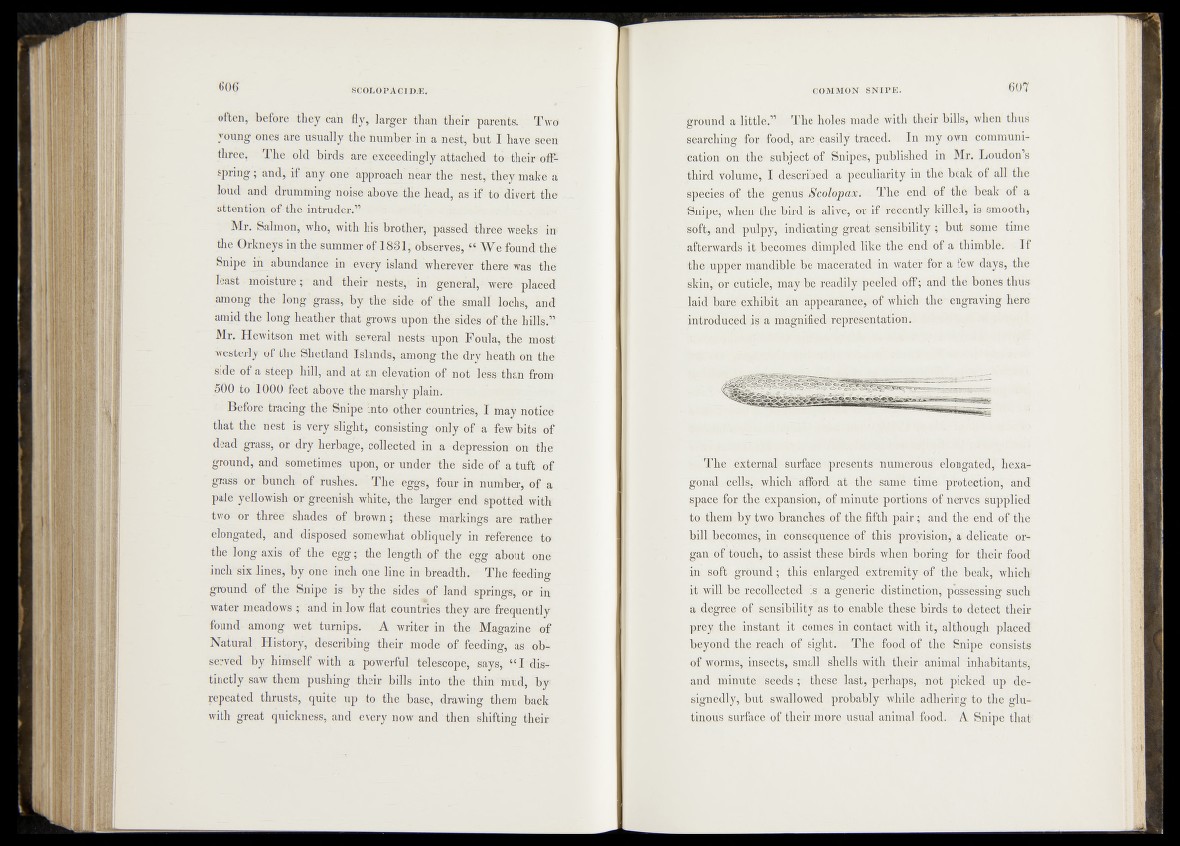
often, before they can fly, larger than their parents. Two
young ones are usually the number-in a nest, but I have seen
three, The old birds are exceedingly attached to their offspring
; and, if any one approach near the nest, they make a
loud and drumming noise above the head, as if to' divert the
attention of-the intruder.”
Mr. Salmon, who, with his brother, passed three weeks in
the Orkneys in the summer of 1881, observes, jgfl We found the
Snipe in abundance in every island wherever there was the
least moisture; and their nests,« in general, Were placed*
among the long‘ grass, by theside o f the small lochs, and
amid the long heather that grows upon‘the sides of the hills.”
Mr. Hewitsoh met with several nests upon Foula, the most
westerly Qf the Shetland Islands,, among the dry heath on the
side of a steep hill, and at an elevation of not less- than from-
5t)0 to 1000 feet above the marshy plain.
Before tracing the Snipe into' other countries, I may notice
that the nest is very slight, Consisting only of a few bits of
dead grass, or dry herbage, , collected in a-depression on the
ground, and sometimes upon, or under the side of a tuffr of
grass or bunch of rushes. The eggs, four in number, of a
pale yellowish-or greenish white, the larger end spotted with
two or three shades of brown; these markings are rather
elongated, and disposed somewhat obliquely in reference; to>
the long axis of the egg; the length'of the egg about one
inch six lines, by one inch one line in breadth. The feeding
ground of the Snipe is by the sides of land springs, or in-
water meadows j and in low flat countries they are frequently
found among wet turnips. A writer in the Magazine of
Natural History, describing their mode of feeding, as observed
by himself with a powerful telescope, says, “ I distinctly
saw them pushing their bills into the thin “mud, by
Repeated thrusts, quite up to the base, drawing them back
with great quickness, and every now and then shifting their
ground a little.” The holes made with their bills, when thus
searching for food, are easil ƒ traced. In my own communication
on the»' subject-of Snipes, published in Mr. Loudon’s
third volume, I described a «peculiarity in the beak of all the
species of the genus Scolopax. The end of thé beak of a
Snipe, when the bird1'is alive, or if recently killed, is smooth,
soft, and pulpy," indicating great sensibility-■$ but some time
afterwards itjbecomes.» dimpled like the-end of a thimble. If
the upper mandible be macerated in water for a few days, the
skin,, omouticle, maybe readily peeled off;! and the bones thus
iaid bare exhibit- an appearance,*of which* the"engraving here
introduced $ a magnified representation;. :
* The. external surface - presents' numerous elongated,*, hexa-
gonal ijcellsp/which' afford at the same-time protection, and
space for the expansion^ of minute portions "of nerves supplied
to them b y two branches #6 fifth pair * and the eUd of the
bill bqGomesy.in consequence «of this provision, a delicate organ
of jtouch,ito assist these birds when boring for their food
in ,*,soft ground; ■ this' enlarged.'extremity of the beak," which-
it will be recollected is a generic distinction^‘possessing such
& degree of Sensibility "asi to enable these birds to detect their
prey the instant it comes in contact with if,'although, placed-
beyond .the reach of sight..- The* food of the Snipe consists
of worms, -insects,. small shells with their animal 'inhabitants,'
and foinuteyseeds; these -last, perhaps, -not picked up de*
signedly, but swallowed .probably while adhering to the glutinous
surface bf. their more usual animal food.. A Snipe that